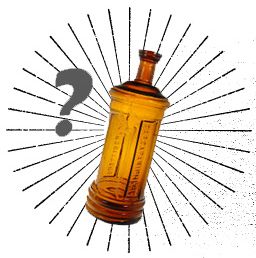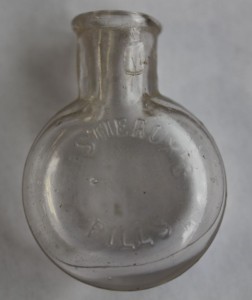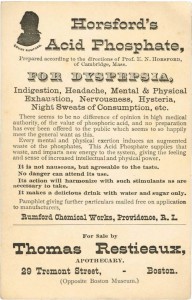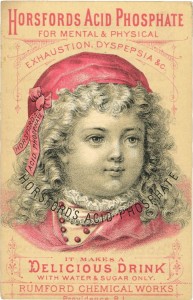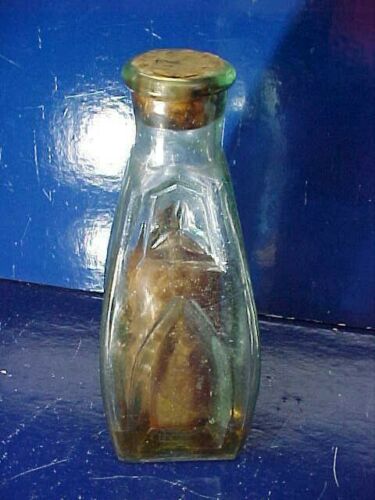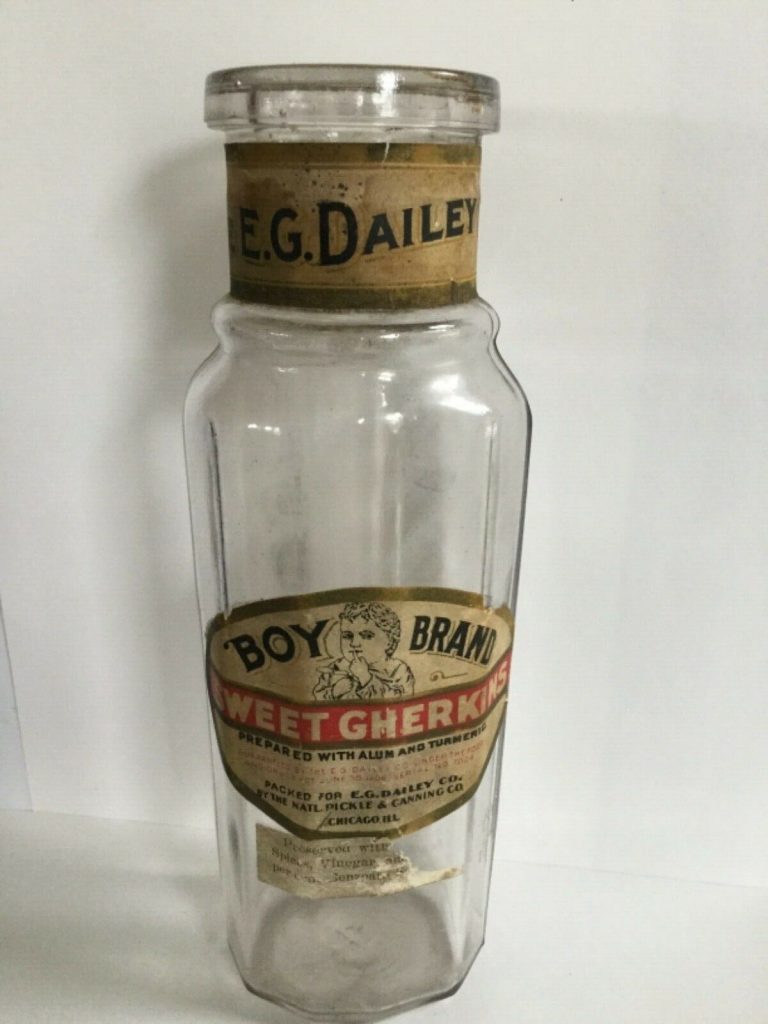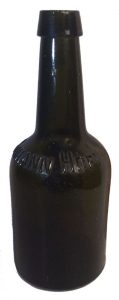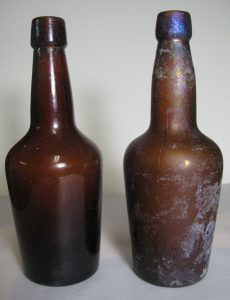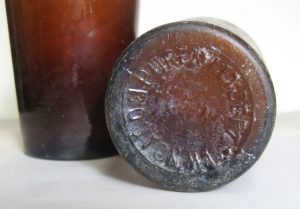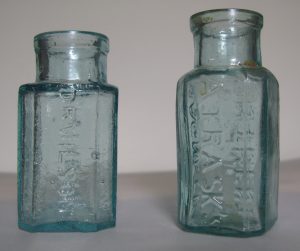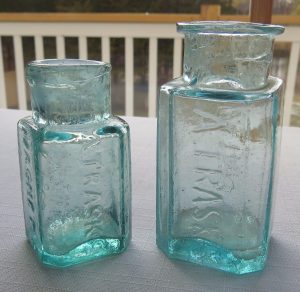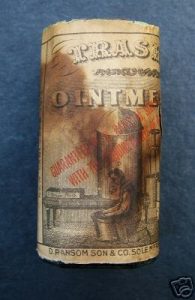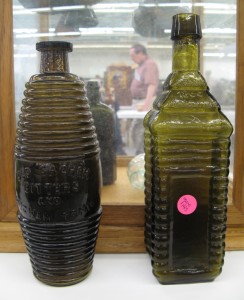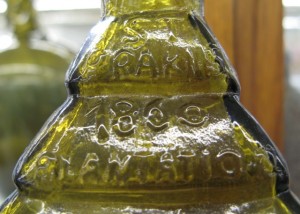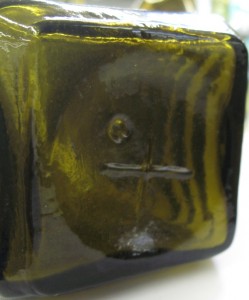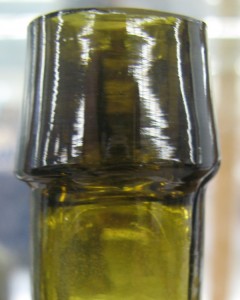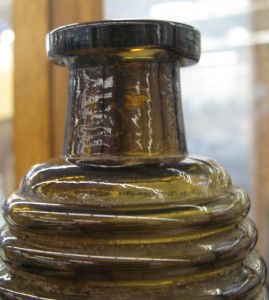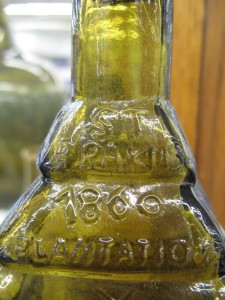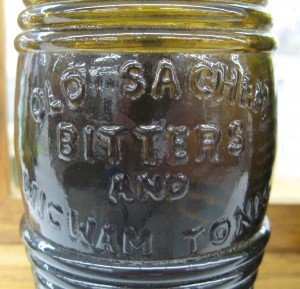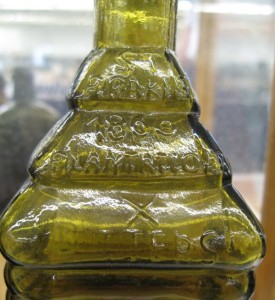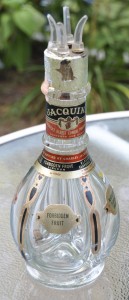What is Castoria?
Samuel Fletcher of Cape Cod and educated at Harvard Medical School developed a formula of simple, non-narcotic ingredients for which he eventually was given a patent on May 12, 1868. Likely the name emerged from the perceived positive health benefits of castor and cod liver oils. The patent lists the ingredients as senna-leaves, bicarbonate of soda, extract of taraxicum, essence of wintergreen and sugar. Senna leaves are still considered a useful laxative today – taraxacum (as it is commonly spelled today) is known to everyone as the dandelion.
The Pitcher’s Castoria Bottles
Most people will encounter rectangular-bodied aqua patent medicine bottles embossed on the side panels about 6″ tall, double collar tooled lip. The embossing reads: DR. S. PITCHER’S // CASTORIA There may or may not be markings on the bottom of the bottle.
These are extremely common Repeat, extremely common! These are so common that back in the 1970s (I think, need to research when) someone was advertising in Old Bottle Magazine trying to assemble enough of these bottles to build an outhouse from them!
There are several other variants known which are scarce.
(a) Front embossed ORIGINAL // DR. SAMUEL PITCHERS // CASTORIA, aqua, recessed panels, also about 6″ tall. Double collar tooled lip. I have seen one example of this with an molded ring midway up the neck of the bottle.
(b) DR. S. PITCHER’S // CASTORIA // BOSTON MASS // PATD. MAY 12 68 The embossing is on the sides and front panels. Square tooled lip. Unmarked on base. 5-1/2″ tall.
(c) PITCHERS on both side panels. BABY BRAND // CASTORIA on front panel. 5-5/8″ tall. Aqua, tooled square lip.
The Pitcher bottles all date to the late 19th century – I do not recall ever seeing any that are machine made nor have I seen any in colors other than aqua.
Fletcher’s Castoria Bottles
The rights to the original Pitcher’s Castoria evolved to the control of Charles Fletcher in the late 1870s although it appears Fletcher’s name and his authorized signature did not appear until around 1890, if I understand Lockhart, et al. correctly.
With success came competition, and lawsuits. Several companies brashly assumed the use of the word castoria and even Pitcher.
Today, most commonly you will find machine-made aqua bottles of a rectangular body which are embossed on the side panels Chas. H. Fletcher (in cursive) and CASTORIA. Earlier tooled top examples are less frequently seen, however they are all quite common including those that retain original labels.
Like the Pitcher’s bottles, these are also extremely common.
Value of Old Pitcher’s and Fletcher’s Bottles
In short, not much. The success of this product means there are literally thousands of examples to be found. It is true that you will see the occasional example sell on eBay, sometimes for even $10-12 plus shipping. However, note that most of the abundant listings never find a buyer.
The asking price for the less common variants falls in the range of $10-40, but this does not necessarily imply that there is a ready market at these prices.
Got Questions About YOUR Bottle?
We have answers, post your antique bottle question and photos in the discussion forum.
Advertising in the 20th Century for Castoria Medicine
Browse through newspaper advertisements in the first half of the 1900s and you will find ads everywhere for Castoria. The ad budget must have been substantial.
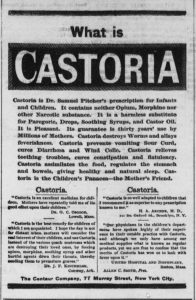
This ad touted the benefits of their product: “..prevents vomiting Sour Curd, cures diarrhoea and Wind Colic. Castoria relieves teething troubles, cures constipation and flatuency. Castoria assimilates the food, regulates the stomach and bowels, giving healthy and natural sleep. Castoria is the Children’s Panacea – the Mother’s Friend.”
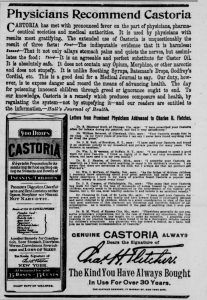
Ths popular ad, picturing a boxed bottle of the Fletcher product, follows a common format of testimonials and includes the official signature of Charles H. Fletcher to warn off competitors.
Further Resources, Information and Photographs.
An thorough research paper by Bill Lockhart et al. on the history both Pitcher, Fletcher, legal entities and product information.
Historical Medical Library, The College of Physicians of Philadelphia, The Dr. Fred B. Rogers Papers, “Dr. Samuel Pitcher (1824-1907): Cape Cod and Castoria” manuscript, letters, and research files, 1980-1981
Here is a photo of Samuel Pitcher taken later in life, with his wife Hannah “Auntie” Pitcher.
Today, the rights to Fletcher’s Castoria are owned by The Mentholatum Company – which markets the product as Fletcher’s Laxative.
Advertisements for Castoria for sale on eBay. (affiliate link, I may make a commission on sales there)
Find-A-Grave page for Samuel Pitcher who is buried in Oak Grove Cemetery, Hyannis, MA
